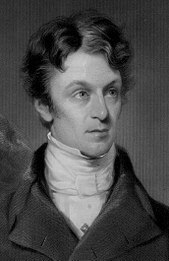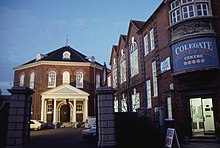James Martineau
James Martineau | |
|---|---|
Manchester New College | |
| Signature | |
James Martineau (/ˈmɑːrtɪnoʊ/; 21 April 1805 – 11 January 1900)[1] was a British religious philosopher influential in the history of Unitarianism.
He was the brother of the atheist
For 45 years he was Professor of Mental and Moral Philosophy and Political Economy in
Many portraits of Martineau, including one painted by
Early life
The seventh of eight children, James Martineau was born in
Education and early years
James was educated at
Martineau's

Martineau's ministerial career was suddenly cut short in 1832 by difficulties growing out of the "
Work and writings
From Dublin, he was called to Liverpool. He lodged in a house owned by Joseph Williamson. It was during his 25 years in Liverpool that he published his first work, Rationale of Religious Enquiry, which caught the attention of many religious and philosophical figures.
In 1840 Martineau was appointed Professor of Mental and Moral Philosophy and Political Economy in
In 1866, the
Martineau was elected a Foreign Honorary Member of the

Life and thought
Martineau described some of the changes he underwent; how he had "carried into logical and ethical problems the maxims and postulates of physical knowledge," and had moved within narrow lines "interpreting human phenomena by the analogy of external nature"; and how in a period of "second education" at
Early years
In his early life he was a preacher. Although he did not believe in the Incarnation, he held deity to be manifest in humanity; man underwent an apotheosis, and all life was touched with the dignity and the grace which it owed to its source. His preaching led to works that built up his reputation:Endeavours after the Christian Life, 1st series, 1843; 2nd series, 1847; Hours of Thought, 1st series, 1876; 2nd series, 1879; the various hymn-books he issued at Dublin in 1831, at Liverpool in 1840, in London in 1873; and the Home Prayers in 1891.[20]

In 1839 Martineau came to the defence of Unitarian doctrine, under attack by Liverpool clergymen including
In Martineau's earliest book, The Rationale of Religious Enquiry, published in 1836, he placed the authority of reason above that of Scripture; and he assessed the New Testament as "uninspired, but truthful; sincere, able, vigorous, but fallible."[22] The book marked him down, among older British Unitarians, as a dangerous radical, and his ideas were the catalyst for a pamphlet war in America between George Ripley (who favored Martineau's questioning of the historical accuracy of scripture) and the more conservative Andrews Norton. Despite his belief that the Bible was fallible, Martineau continued to hold the view that "in no intelligible sense can any one who denies the supernatural origin of the religion of Christ be termed a Christian," which term, he explained, was used not as "a name of praise," but simply as " a designation of belief."[23] He censured the German rationalists "for having preferred, by convulsive efforts of interpretation, to compress the memoirs of Christ and His apostles into the dimensions of ordinary life, rather than admit the operation of miracle on the one hand, or proclaim their abandonment of Christianity on the other".[24][20]
Transcendentalism
Martineau came to know German philosophy and criticism, especially the criticism of
Martineau's theory of religious society, or church, was that of an idealist. He propounded a scheme, which was not taken up, that would have removed the church from the hands of a clerical order, and allowed the coordination of sects or churches under the state. Eclectic by nature, he gathered ideas from any source that appealed. Stopford Brooke once asked A. P. Stanley, Dean of Westminster, "if the Church of England would broaden sufficiently to allow James Martineau to be made Archbishop of Canterbury".[26]



Later years
Although he had opposed the removal (1889) of Manchester New College to Oxford, Martineau took part in the opening of the new buildings, conducting the communion service (19 October 1893) in the chapel of what is today
A wide circle of friends mourned his death on 11 January 1900; Oscar Wilde references him in his prose.[28]
He was buried in a family grave on the eastern side of Highgate Cemetery. One of his daughters was the watercolourist Edith Martineau who was interred in the family grave in 1909. The Martineau Memorial Hall in Norwich was built in 1907 and named after celebrated members of the family who had long resided in the area and were deacons of the chapel to which the hall was attached. However, unofficially, the hall was named after James who had died within recent years having established the hall's Sunday school some decades earlier.[29]
Bibliography
- Endeavours after the Christian Life (1843);
- Miscellanies 1852;
- The Rationale of Religious Enquiry: or, The question stated of reason, the Bible, and the church; in six lectures (1853);
- Studies of Christianity : a series of papers (1858);
- A Study of Spinoza (1882)
- Types of Ethical Theory (1885)
See also
References
- ^ "Obituary - Dr. James Martineau, London - January 12, 1900". The West Australian. 15 January 1900. p. 5. Retrieved 15 January 2014.
- , retrieved 18 November 2023
- ^ a b c d e Fairbairn 1911, p. 797.
- ^ Furness, Hannah. "Duchess of Cambridge visits National Portrait Gallery - home of little known Middleton family paintings". UK Daily Telegraph - page 3. UK Daily Telegraph - February 11th, 2014. Retrieved 9 May 2014.
- ^ Gallery, London, National Portrait. "George Frederick Watts,- Portrait of James Martineau, 1873". NPG, London, 2014. Retrieved 15 January 2014.
- ^ Greenwood, Grace (1883). Queen Victoria, her girlhood and womanhood. Montreal: Dawson Bros. Retrieved 21 January 2014.
- ^ Cobbe, Frances Power (1904). "London in the Sixties and Seventies". Life of Frances Power Cobbe as Told by Herself. London: Swan Sonnenschein & Co, Lim. p. 509.
- ^ Tree, Chamberlain Family. "Chamberlain Family". Graham Wall copyright 2001. Archived from the original on 24 September 2015. Retrieved 20 January 2014.
Note connection of Martineau, Kenrick, Nettleford and Chamberlain families (1862-1945)
- ^ Ruston, Alan. "Joseph Chamberlain". UUDB. c2011. Retrieved 20 January 2014.
- ^ Rowe 1959, chapter 6.
- ^ Rowe 1959, chapter 8.
- ISBN 9780804711463.
(May 1857) My (H. Martineau) niece, Mrs (Frances) Lupton and her husband came for two days
- ^ Hooper, James (1913). Souvenir of the George Borrow Celebration. Jarrold & Sons. p. 14.
- ^ Ronalds, B.F. (February 2018). "Peter Finch Martineau and his Son". The Martineau Society Newsletter. 41: 10–19.
- ^ Rowe 1959, chapter 1.
- ^ Carpenter, J. Estlin. James Martineau, theologian and teacher; A study of his life in thought. Philip Green, Essex Street, London, 1905, Chapter VII.
- ^ University of Oxford, Harris Manchester College -. "Archives and History - Harris Manchester College, University of Oxford". hmc.ox.ac.uk. Harris Manchester College Pty Ltd. Archived from the original on 18 October 2014. Retrieved 22 September 2014.
- ^ Fairbairn 1911, pp. 797–798.
- ^ "Book of Members, 1780–2010: Chapter M" (PDF). American Academy of Arts and Sciences. Retrieved 23 September 2016.
- ^ a b c d e f Fairbairn 1911, p. 798.
- ^ Tiffany K. Wayne, Encyclopedia of Transcendentalism (2006), p. 179.
- ^ James Martineau, The Rationale of Religious Enquiry (London, 1836), p. 17.
- ^ James Martineau, The Rationale of Religious Enquiry (London, 1836), "Preface to the Second Edition", p. x.
- ^ Martineau, James (1836). "Rationalism". The Rationale of Religious Enquiry. London: Whittaker and Co, Simpkin and Marshall, and R. Hunter. p. 133.
- ^ Martineau, James. The Seat of Authority in Religion
- doi:10.1093/ref:odnb/18229. (Subscription or UK public library membershiprequired.)
- ^ A.G. "Entry - James Martineau". Oxford Dictionary of National Biography. Oxford University Press - (Date of original publication - 1901). Retrieved 22 January 2014.
- ISBN 9781596050969. Retrieved 15 January 2014.
- ^ (England), Norwich (1936). Official Guide to the City of Norwich. Retrieved 3 April 2023.
Sources
- J. Hunt, Religious Thought in England in the 19th Century (1896) pages 246–250;
- A. W. Jackson, James Martineau, a Biography and a Study (Boston, 1900);
- J. Drummond and C. B. Upton, Life and Letters (2 volumes, 1901);
- Henry Sidgwick, Lectures on the Ethics of Green, Spencer and Martineau (1902);
- A. H. Craufurd, Recollections of James Martineau (1903);
- J. E. Carpenter, James Martineau, Theologian and Teacher (1905);
- C. B. Upton, Dr. Martineau's philosophy, a survey (1905);
- Rowe, Mortimer (1959). The History of Essex Hall. London: Lindsey Press. Archived from the original on 16 January 2012.
- Frank Schulman, James Martineau: This Conscience-Intoxicated Unitarian (2002).
Attribution
- This article incorporates text from a publication now in the public domain: Fairbairn, Andrew Martin (1911). "Martineau, James". In Chisholm, Hugh (ed.). Encyclopædia Britannica. Vol. 17 (11th ed.). Cambridge University Press. pp. 797–800.
External links
 Quotations related to James Martineau at Wikiquote
Quotations related to James Martineau at Wikiquote- Works by James Martineau at Project Gutenberg
- Works by or about James Martineau at Internet Archive
- Portraits of James Martineau at the National Portrait Gallery, London
